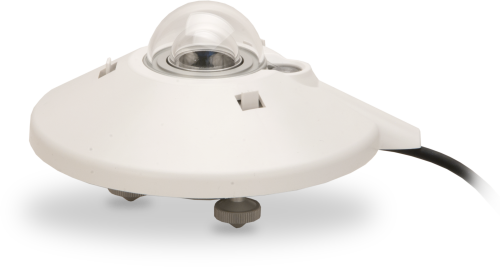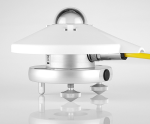
測定のために最適化された内蔵サーミスタ






概要
Kipp & Zonen 製の CMP21 は、内部サーミスタを備えた ISO Class A (二次準器) 日射計です。全太陽スペクトル範囲の日射を監視し、科学的な用途やトップレベルの日射監視ネットワークに最適です。この日射計は、Campbell Scientific データ ロガーに直接接続します。
続きを読む利点と特徴
- 個別に最適化された温度補正のためのサーミスターを内蔵
- ほとんどの Campbell Scientific データロガーとの互換性
- 遮光シールドを外さずに確認できる内蔵の気泡水準器
- 乾燥剤入りの乾燥カートリッジにより、ドームの内側の結露を防止
- ドームを氷や結露から守る CVF4 ヒータ/ベンチレータとの互換性
- 反転させて反射日射を測定
- 直射日光下、植物のキャノピー、曇り空、人工照明の下での測定を提供
イメージ








類似製品
詳細
仕様
| センサ | 2 つのガラスドームで保護された高品質の黒色サーモパイル |
| 測定の説明 | 太陽スペクトル範囲全体の太陽放射を監視 |
| ISO クラス | クラス A (二次標準) |
| 測定範囲 | 285 ~ 2800 nm |
| 感度 | 7 ~ 14 µV/W/m2 |
| 感度の温度依存性 | < 1% (-20° ~ +50°C) |
| 応答時間 | < 5 秒 (95%) |
| 熱放射によるゼロ オフセット | < 7 W/m2 (200 W/m2) |
| 非安定性 | < 0.5% (年間変化) |
| 非直線性 | < 0.2% (0 ~ 1000 W/m2) |
| 方向誤差 | < 10 W/m2 (1000 W/m2 ビームで最大 80°) |
| 傾斜誤差 | < 0.2% |
| レベル精度 | 0.1° |
| インピーダンス | 10 ~ 100 Ω |
| 動作温度範囲 | -40° ~ +80°C |
| 一般的な信号出力 | 0 ~ 15 mV (大気アプリケーション用) |
| 最大放射照度 | 4000 W/m2 |
| 予想される日次不確実性 | < 2% |
| ドーム直径 | 5 cm (2 in.) |
| 幅 | 15 cm (5.9 in.) シールド含む |
| 高さ | 9.25 cm (3.64 in.) |
| 重量 | 0.9 kg (2 lb) 10.1 m (33 ft)ケーブルの場合 |
互換性
注意: 以下は代表的な互換性情報を示しています。互換性のある製品や互換性のない製品をすべて網羅したリストではありません。
Data Loggers
| 製品 | 互換性 | 注意 |
|---|---|---|
| CR1000 (リタイア) | ||
| CR1000X (リタイア) | ||
| CR300 (リタイア) | ||
| CR3000 (リタイア) | ||
| CR310 | ||
| CR350 | ||
| CR6 | ||
| CR800 (リタイア) | ||
| CR850 (リタイア) |
互換性に関する追加情報
取り付け
CMP21 には気泡水準器と 2 つの水平調整脚が付いており、水平調整ベースを使用せずに水平調整できます。この日射計は、CM255 または CM255LS 取り付けスタンドを介してマスト、クロスアーム、またはポール (外径 1.0 ~ 2.1 インチ) に取り付けます。CMP21 は、測定に悪影響を与える可能性のあるすべての障害物や反射面から離れた場所に取り付ける必要があります。
よくある質問
CMP21-Lに関するよくある質問の数: 9
すべて展開すべて折りたたむ
-
いいえ。これらはすべて、測定に応じて独自の電圧信号を生成する受動デバイスです。ただし、これらのセンサ (CVF4-L) には、電源を必要とするヒーターとベンチレーターがあります。
-
測定に追加のノイズが混入する可能性があることを承知の上で、ケーブル長 300 フィートを使用できます。通常、日射計を備えたシステムでは、センサはデータロガーの近く (50 フィート以内) に設置されます。アプリケーションで長いリード線が必要な場合は、Campbell Scientific にお問い合わせください。
-
すべてのセンサに異なるケーブル終端オプションがあるわけではありません。特定のセンサで利用可能なオプションは、センサ製品ページの注文情報エリアの 2 つの場所で確認できます。
モデル番号
ケーブル終端オプション リスト
センサが –ET、–ETM、–LC、–LQ、または –QD バージョンで提供されている場合、そのオプションが利用可能かどうかはセンサモデル番号に反映されます。たとえば、034B は 034B-ET、034B-ETM、034B-LC、034B-LQ、および 034B-QD として提供されています。その他のすべてのケーブル終端オプション (利用可能な場合) は、センサ製品ページの注文情報エリアの「ケーブル終端オプション」の下にリストされています。たとえば、034B-L 風力発電セットは、034B-L 製品ページの注文情報エリアに示されているように、–CWS、–PT、および –PW オプションで提供されています。
注意: 新しい製品が在庫に追加されると、通常は複数のモデル番号を作成するのではなく、1 つのセンサモデルの下に複数のケーブル終端オプションをリストします。たとえば、HC2S3-L には、HC2S3-LC モデルではなく、CS110 に接続するための –C ケーブル終端オプションがあります。
-
Campbell Scientific のセンサのほとんどは、ユーザー指定のケーブル長を示す –L として提供されています。センサが –LX モデル (「X」は他の文字) としてリストされている場合、そのセンサのケーブルの長さはユーザー指定ですが、固有のシステム用の特定のコネクタで終端されます。
- -LC モデルには、ET107、CS110、または廃止された Metdata1 に接続するためのユーザー指定のケーブル長があります。
- -LQ モデルには、RAWS-P 気象ステーションに接続するためのユーザー指定のケーブル長さがあります。
センサのメイン モデル番号の後に –L または –LX の指定がない場合、センサのケーブル長は設定されています。ケーブル長は、製品の注文情報の説明フィールドの末尾に記載されています。たとえば、034B-ET モデルの説明は、「ET ステーション用 Met One Wind セット、67 インチ ケーブル」です。ケーブル長が設定されている製品は、デフォルトでバラ線で終端されます。
ケーブルが特定のシステム用の特別なコネクタで終端されている場合、モデル番号の末尾でそのシステムを指定します。たとえば、034B-ET モデルは、ET107 システムのセンサを 034B として指定します。
- –ET モデルは、ET107 気象ステーション用のコネクタです。
- –ETM モデルは ET107 気象ステーション用のコネクタですが、交換部品を購入するときに便利な特別なシステム マウントも含まれています。
- –QD モデルは、RAWS-F クイック展開ステーション用のコネクタです。
- –PW モデルは、PWENC または配線済みシステム用のコネクタです。
-
ISO および WMO は、CMP6-L などのファーストクラスの日射計をネットワーク運用に適していると分類しています。ただし、正確度が最優先の場合は、代わりに CMP11-L や CMP21-L などのクラス A 日射計の使用を検討してください。
-
はい。各日射計には、Kipp & Zonen 社製の取扱説明書が付属しており、その構造、スペクトル感度、コサイン応答、簡単なセンサ チェックアウト手順に関する情報が記載されています。センサとマニュアルには、センサ感度値とシリアル番号が記載された校正証明書が付属しています。
-
多くの Campbell Scientific センサは、さまざまなケーブル終端オプションで利用できます。これらのオプションには次のものがあります。
- –PT (–PT w/Tinned Wires) オプションはデフォルトのオプションであり、他のオプションのように製品ラインには表示されません。ケーブルは、データロガーに直接接続するバラ線で終端します。
- –C (–C w/ET/CS110 コネクタ) オプションでは、ケーブルは CS110 電界メータまたは ET シリーズ気象ステーションに接続するコネクタで終端します。
- –CWS (–CWS w/CWS900 コネクタ) オプションでは、ケーブルは CWS900 シリーズ インターフェイスに接続するコネクタで終端します。CWS900 シリーズ インターフェイスに接続すると、センサをワイヤレス センサー ネットワークで使用できるようになります。
- –PW (–PW w/Pre-Wire Connector) オプションでは、ケーブルは事前に配線されたエンクロージャに接続されるコネクタで終端します。
- –RQ (–RQ w/RAWS コネクタ) オプションでは、ケーブルは RAWS-P 常設リモート自動気象ステーションに接続するコネクタで終端します。
注意: ケーブル終端オプションの選択肢はセンサによって異なります。たとえば、センサには選択可能なオプションがまったくないか、複数ある場合があります。特定のセンサに必要なオプションがリストされていない場合は、Campbell Scientific に問い合わせてサポートを受けてください。
-
IR 放射の損失のため、ほぼすべてのサーモパイル計器には通常、負のオフセットがあります。このオフセットは夜間に最も目立ち、ゼロではなく小さな負の値が読み取られます。この同じオフセットは日中にも存在しますが、太陽信号が大きいため目立ちません。
もう 1 つの一般的な問題は、計器の水平調整です。サーモパイル計器の水平調整では、コサイン応答が正しくないため、直接ビーム成分にエラーが発生する可能性があります。太陽が地平線に近い場合、角度が非常に浅いため、これらのエラーはより顕著になります。
-
これらの全日射計は、表面に当たる太陽短波放射量を測定します。CMP11-L と CMP21-L は、その正確度と性能レベルにより、国際標準化機構 (ISO) と世界気象機関 (WMO) によって二次準器センサに分類されており、日射計による測定の最高レベルを表しています。これに対して、CMP6-L は、日射計の中間の分類であるファースト クラス センサに分類されています (セカンド クラスは、日射計の最低の分類です)。
Privacy Policy Update
We've updated our privacy policy. 詳細はこちら
Cookie Consent
Update your cookie preferences. クッキーの設定を更新する
